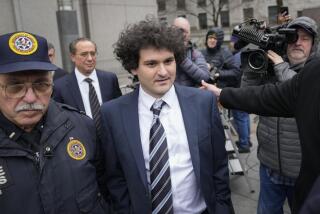The Clandestine Operation That May Have Saved Pan American : Airlines: Steps leading to its bankruptcy protection filing were taken in secrecy. Publicity might have doomed the effort--and the company.
- Share via
NEW YORK — Tom McClain had spent an exhausting day on the slopes. His vacation at Austria’s St. Anton ski resort marked the first time in many months that he had been able to get away with his wife and four children. McClain had just put his head on the pillow when the phone rang at 10 p.i.
“Be in New York tomorrow afternoon. We’re going to discuss the Middle East crisis,” the voice on the other end ordered.
It was Thursday, Jan. 3. Thus began a weekend that McClain, the Frankfurt, Germany-based vice president of Pan American World Airways’ Atlantic division, would never forget. After a few hours of fitful sleep, the 53-year-old executive arrived in New York on Friday after a mad dash across the Atlantic via Innsbruck, Austria, and Frankfurt.
Panting into the airline’s downtown New York offices at 3:30 p.m., he joined about 50 other high-ranking Pan Am executives for the top-secret meeting.
The crisis in the Middle East had been a perfect ruse for the beleaguered airline’s hierarchy. Actually, Chairman Thomas G. Plaskett had summoned the managers to home base to tell them that Pan Am, which pioneered international air travel, was going to bankruptcy court early the following week.
Pan Am executives’ worst fear that weekend was that the carrier would have to file for Chapter 7 liquidation instead of seeking protection under Chapter 11 of the U.S. Bankruptcy Code while reorganizing the company. The airline was frightfully short of cash, and among the tasks to be accomplished during the next few days was persuading United Airlines to advance cash on its pending purchase of Pan Am’s London routes.
Unless it got an immediate $150 million, Pan Am, a 50-year-old American brand name once as familiar overseas as Coca-Cola, might be grounded on Monday morning. A decade of deregulation, which had seen competitors grab more and more of Pan Am’s foreign market, had taken a toll. Lack of a domestic route system to feed into its overseas operations put Pan Am at even more of a disadvantage.
If the carrier was to navigate safely to bankruptcy court, absolute secrecy was required until it was ready to act.
The weekend activities resembled a CIA operation. Pan Am was given the code name Eagle. Interoffice communications were handwritten. All of the executives summoned to New York had been called on the telephone. No telexes or faxes were allowed.
A late Monday night meeting of the board was held in a secret location away from headquarters to avoid arousing curious outsiders who might spot them.
The weekend’s garbage was retained for fear that scraps holding secrets might get into the wrong hands. Everyone connected with the operation--from the public relations counsel and advertising agency to secretaries--had to sign a confidentiality agreement. Uniformed guards stood at the entrance to the 46th-floor executive suite in the Pan Am building in downtown Manhattan. As in a military operation, command posts were set up New York, Frankfurt, London and Rio de Janeiro.
Investment bankers huddled. Lawyers rewrote the fine print. There were hush-hush phone calls between weary attorneys in New York and the top executives of United Airlines in Chicago. The super secrecy was essential to Pan Am’s strategy for a Chapter 11 filing.
If word leaked out before it was ready, it was sure to be misconstrued, the airline reasoned. The public and the travel agents, Pan Am’s lifeblood, might certainly misunderstand, probably jumping ship to other carriers.
It was to be business as usual. Schedules were to remain intact. No flights would be canceled. No employees would be ousted, and all future bills would be paid. As far as the public would notice, nothing would change.
Despite the hush-hush atmosphere, a large cast of characters had to be let in on the “secret.” By Tuesday morning, when the papers were finally filed in bankruptcy court in New York, the group had grown to more than 200 people--making Pan Am’s success at keeping the facts out of the public eye until the actual filing all the more remarkable.
“It was my view that we do not bring in a large group of people into this until the last possible moment,” said Peter T. McHugh, the airline’s executive vice president and chief operating officer. “Bringing people in sooner would have let the word get out.”
Nevertheless, there were already whispers of Pan Am’s possible demise, prompting American Express and MasterCard, for example, to hold funds owed to Pan Am to have a pool to repay cardholders if the carrier stopped flying.
Pan Am repeatedly denied it, but it had actually been preparing for a bankruptcy filing for at least six months, McHugh conceded in an interview. It was not a question of if, just when.
Early on, it hired Kekst & Co., a public relations firm that specializes in crisis management. Kekst immediately drew up a 50-page contingency plan that developed a strategy for the bankruptcy announcement. It included everything from a sample letter to President Bush informing him of a bankruptcy to instructions on how to inform workers that their pay checks would be honored.
“The first 48 to 72 hours are critical in positioning the entire communications and marketing strategy,” warned the contingency plan. “If Eagle can make it through this period with minimal damage, it may be able to convince the flying public, travel agents and Eagle employees that Eagle remains a viable carrier.” Lest the report get into the wrong hands, Kekst made only about six copies for top Pan Am executives--and initialed each.
During the weekend, numerous news releases were being prepared at Kekst. Under the watchful eyes of Kekst partner Jeffrey Taufield, different releases for different eventualities had to be ready for Tuesday morning. Never mind that the exact news to be distributed wasn’t known yet.
Every release carried the code name Eagle. Secretaries who worked on papers were kept in the dark. Meanwhile, at Pan Am’s advertising agency, Della Femina McNamee Inc., post-bankruptcy ads--to be used immediately after the filing--were being written clandestinely.
Secret, round-the-clock sessions on Pan Am’s crisis were taking place in about half a dozen other places, as well.
One such meeting would determine if Pan Am would survive or throw in the towel. Without an advance against the sale of its London routes to United Airlines, things looked bleak.
Pan Am was ultimately to get $290 million for the routes. But it needed an advance to allow it to keep operating until the transaction was approved by U.S. government agencies and until a disagreement with the British government over landing rights at London’s Heathrow Airport could be worked out. The sale could not go forward until that squabble was resolved.
Jonathan O’Herron, a white-haired, soft-spoken partner in Lazard Freres & Co., Pan Am’s investment banker, called a meeting of Pan Am, United Airlines and Bankers Trust Co. officials that ran the entire weekend. Bankers Trust had guaranteed that it would come up with $100 million in so-called bridge financing, but only if United provided the remaining $50 million.
At first, persons close to the negotiations recalled, United balked at providing more advances to Pan Am. It had come up with $20 million just a few weeks earlier. All Monday night, Lazard Freres, Bankers Trust and United officials haggled on the phone.
“There were plenty of times right up until we signed the agreement at 6 a.m. Tuesday that we were worried that the deal would fail,” recalls O’Herron. Collateral for the loan was a stumbling block, he added.
“You can’t operate without cash,” said one person close to the situation. “And Pan Am was almost out of cash that weekend. Chapter 7 liquidation certainly was in the back of the minds of some people.” According to later court testimony, Pan Am was down to its last $38 million when it finally got the loan.
Peter Atkins, a tough securities lawyer who seldom smiles, conducted the negotiations for United from the Manhattan headquarters of his law firm, Skadden, Arps, Slate, Meagher & Flom.
In Chicago, United Airlines was hosting a black-tie banquet at the swank Four Seasons Hotel for 300 business and civic leaders to celebrate the start-up of its Chicago-to-Tokyo route Tuesday.
When the dinner was over and the guests headed home, United Chairman Stephen M. Wolf, Vice Chairman Jack C. Pope and General Counsel Lawrence Nagin sent their wives home. Still in their tuxedos, they headed for a conference room upstairs in the hotel to intensify the negotiations and to direct Atkins in New York.
As dawn began to break Tuesday, an agreement was reached. There was one more thing that had to be done. The United board still had to approve the agreement. An early morning board meeting was conducted by conference call. Members as far away as Hawaii participated.
The Pan Am regional managers had returned to their stations Sunday to be in place at the proper time. Everybody had an assignment: At the time of the filing, Plaskett was to call New York Gov. Mario M. Cuomo and U. S. Transportation Secretary Samuel K. Skinner. Lower-ranked executives would call people in their respective countries, including union representatives, foreign government and U.S. Embassy officials.
The bankruptcy court had been asked Monday evening to have clerks available an hour earlier than usual Tuesday morning. The court had been told only that a major corporation would file for Chapter 11.
It was 8:31 a.m. Tuesday when the Dow Jones Financial News Wire told the world.
More to Read
Inside the business of entertainment
The Wide Shot brings you news, analysis and insights on everything from streaming wars to production — and what it all means for the future.
You may occasionally receive promotional content from the Los Angeles Times.










